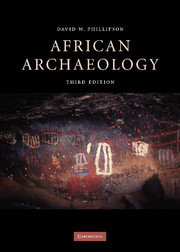Book contents
- Frontmatter
- Contents
- List of illustrations
- Sources of illustrations
- Preface
- 1 Introduction
- 2 The emergence of humankind in Africa
- 3 The consolidation of basic human culture
- 4 Regional diversification and specialisation
- 5 The beginnings of permanent settlement
- 6 Early farmers
- 7 Iron-using peoples before AD 1000
- 8 The second millennium ad in sub-Saharan Africa
- Bibliographic guide
- Bibliographic references
- Index
5 - The beginnings of permanent settlement
Published online by Cambridge University Press: 05 June 2012
- Frontmatter
- Contents
- List of illustrations
- Sources of illustrations
- Preface
- 1 Introduction
- 2 The emergence of humankind in Africa
- 3 The consolidation of basic human culture
- 4 Regional diversification and specialisation
- 5 The beginnings of permanent settlement
- 6 Early farmers
- 7 Iron-using peoples before AD 1000
- 8 The second millennium ad in sub-Saharan Africa
- Bibliographic guide
- Bibliographic references
- Index
Summary
This chapter describes and considers the significance of trends towards increased sedentism that occurred in final Pleistocene and early Holocene times over wide areas of northern and parts of eastern Africa. Rooted in the culture of their hunter-gatherer predecessors, some societies of this period are now seen as having provided the basis for the later adoption of herding and cultivation. The relevant literature is particularly confusing because of the various terminologies that have been applied, similar adaptations being designated Mesolithic, Epipalaeolithic, Late Stone Age or even Neolithic by different authors (cf. Vermeersch 1992). More than any other in this book, this chapter cuts across conventional time-divisions in its treatment of an important but localised process of African cultural development, but it provides a vital conceptual link between the predominantly foraging societies and those whose base in cultivation and/or herding has provided the foundation for much of the continent's more recent development.
North Africa, the Sahara and the Nile Valley
It was noted in chapter 4 how the greater part of the Sahara had little or no human settlement during the arid period which broadly corresponded with the coldest part of the last northern-hemisphere glaciation. There are clear geomorphological traces, such as now-consolidated sand dunes (Roset 1987; Breunig and Neumann 2002), which indicate that the desert at this time extended even further to the south than it does today.
- Type
- Chapter
- Information
- African Archaeology , pp. 147 - 164Publisher: Cambridge University PressPrint publication year: 2005



